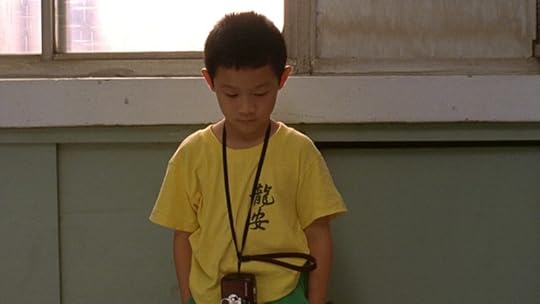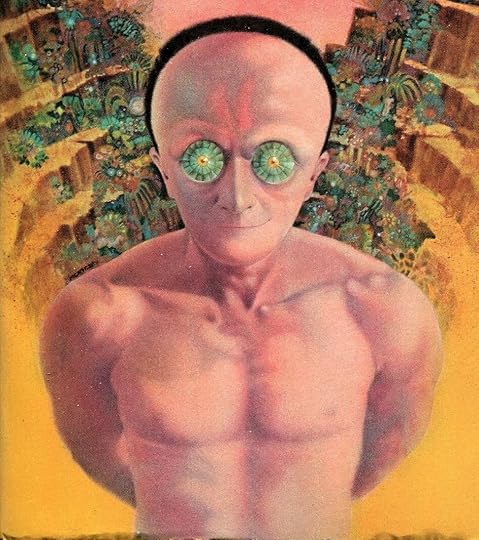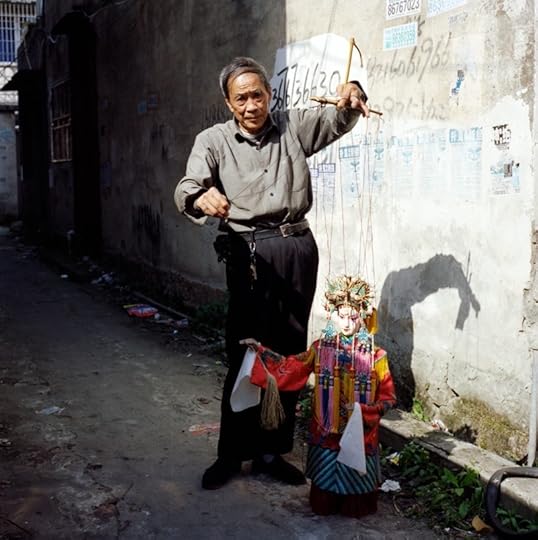Alan Jacobs's Blog, page 120
April 28, 2022
“You can’t see it so I help you”

There’s a lot going on in Edward Yang’s masterful Yi Yi (2000), but I just want to focus on one theme here: how an eight-year-old boy named Yang-Yang is confronted by an epistemological conundrum. He realizes, first, that he can’t be sure that other people see what he sees; and second, that he can only know half of the truth about the world, because he can only see what’s in front of him — what’s behind him remains always invisible.
Yang-Yang responds to this difficulty by getting a camera. It takes him a while to learn how to use it properly: at school a teacher confiscates a stack of blurry, uncomposed photos and mocks them as “avant-garde art.” But gradually he gets the hang of his new device, and finds his true subject: the backs of heads — as many of them as he can photograph. Late in the movie he hands his uncle a photo. The uncle is confused at first, but then realizes that it’s the back of his own head. “You can’t see it so I help you,” Yang-Yang says, to which his father replies, “So that’s what this is all about.” (It may not be irrelevant that the uncle is notable for his complete lack of self-knowledge.)
Yang-Yang’s father, NJ, has troubles of his own, including conflict with his co-workers; a wife, Min-Min, who has fallen into deep depression when her stroke-afflicted mother becomes comatose; and the sudden reappearance in his life of his first love, a woman named Sherry. When NJ and Sherry talk we typically see him from behind — we see only the back of his head. What message his face carries is not for us to know.
There is one exception to this rule, though. When Min-Min’s mother is brought home in a coma, the doctors tell the family to speak to her every day. Tell her what they’ve been doing, whatever, but speak to her because maybe — the doctors don’t have much hope of this, but still — maybe that will help bring her back. When they do this we see their faces; the blanket-covered lower body of the unconscious old lady is visible just at the edge of the frame. At one point NJ visits, in the midst of his struggle with what to do about Sherry’s reappearance, and says, in highly general terms, that he’s having a tough time. We see his full face throughout this scene. Also: he comments, “This is like praying, you don’t know whether the person you’re talking to hears you.” But we know she doesn’t see him.
Late in the movie, when Min-Min returns from an extended period of retreat in a Buddhist monastery, she tries to tell NJ what she has learned — and what she has not learned. She sits, distressed, at the foot of their bed, while he sits near the head of it — behind her. He sees only the back of her head; she doesn’t see him at all. Yet they speak words of remarkable honesty to one another; perhaps some things are easier to say when you’re not looking into someone’s eyes. Perhaps also that’s why it can be easier to talk to a comatose person who probably can’t hear you than to talk to an angry or unhappy member of your family.
It’s noteworthy, perhaps, that Yang-Yang shares part of a name with the film’s director, because Edward Yang repeatedly films his characters through glass, in such a way that we see those characters but also reflections in the glass — reflections that show us what is behind the camera. Maybe, then, this is one of the roles of movies: to show us that half of the truth that we don’t ordinarily see, that we’re debarred from seeing. (One teenage character: “My uncle says we live three times as long since man invented movies…. It means movies give us twice what we get from daily life.” I’d like to know his uncle’s name.)
One more note: In A Room of One’s Own Virginia Woolf writes: “For there is a spot the size of a shilling at the back of the head which one can never see for oneself. It is one of the good offices that sex can discharge for sex — to describe that spot the size of a shilling at the back of the head…. A true picture of man as a whole can never be painted until a woman has described that spot the size of a shilling.”
April 27, 2022
department of corrections
My friend Joe Mangina — who, unlike me, is a real theologian — has written to correct something I wrote in my sketch of a demonology.
I would only question your naming of Sin and Death as being among the Pauline “principalities and powers.” It seems to me that these fall in a fundamentally different category. The principalities are created realities, of God knows what ontological status, but anyway created and, tragically corrupted. But Sin and Death aren’t created. They are names for the corruption — for Evil — itself. This may seem a theologian’s quibble, and I’m happy to acknowledge that from the ordinary mortal’s point of view these are all powers or systems opposed to God that enslave humans. But it does make a difference. The powers can be — at least eschatologically and in principle — redeemed; Sin and Death, not so.
This is precisely right, and not at all a quibble. (And I knew better! Annoyingly sloppy on my part.)
We don’t really understand the “ontological status” of the Powers: I wrote about some of the complications here. Demons, whom I describe as the agents of the Powers, are equally difficult to fix ontologically, as we may note when we hear “My name is Legion, for we are many” (Mark 5:9).
Moreover, it has not always seemed clear to Christians that angels, demons, and human beings exhaust the categories of sentient creatures. Milton writes darkly of “middle Spirits” whose nature lies “Betwixt the angelical and human kind” (Paradise Lost, Book III). In The Discarded Image C. S. Lewis details the medieval belief in creatures whom he calls longaevi — these are very close to Tolkien’s Elves — whose place in the drama of human salvation is uncertain and debatable. In That Hideous Strength Lewis has one character speculate about the existence of “neutrals” — beings who originally were not concerned with the spiritual warfare that dominates the human world but who are being drawn into that conflict, being compelled to choose a side, as we all ultimately will.
But in the end, this much can be said about all sentient creatures: At the name of Jesus every knee shall bend, in heaven and on earth and under the earth, and every tongue should confess that Jesus Christ is Lord, to the glory of God the Father (Philippians 2:10-11). That includes the Powers, the angels, the demons, the rulers of this world (kosmokratoras), and humans made in the image of God.
But it does not include Sin and Death, which shall be eradicated. That’s the key difference: All powers and rulers, whether in the end redeemed or not, will confess the One Lord who is the Way, the Truth, and the Life. But Sin and Death will be altogether destroyed.
April 26, 2022
“Hi, I’d like to add you to my professional network on Li...
DBH: [T]he religion historically called “Christianity” i...
DBH:
[T]he religion historically called “Christianity” is not a “truth” that exists among and in competition with “false” non-Christian religions. “Christianity,” in fact — which is not really one thing, in any event, but only a loose designation for a diverse set of beliefs and practices and cultural forms and numerous often incongruous religions, comprised within a single but nonetheless porous hermeneutical and historical “set” — is only one limited trajectory within history’s universal narrative of divine incarnation and creaturely deification, superior in some ways to alternative trajectories, vastly inferior in many others. (A strictly Reformed theology of, say, penal substitutionary atonement is infinitely more remote from the Logos who has become incarnate in created nature and history than is, for instance, the bodhisattva ideal unfolded in the Lotus Sutra and the Bodhicaryavatara; indeed, the latter in some very real sense attests, under the veil of the unfamiliar, to the truth made present in Christ, while the former is totally antithetical to that truth and therefore pure falsehood.)
So religious traditions that deny every single clause of the ancient Christian creeds nevertheless “in some very real sense” — real but, alas, undefined — attest to the truth of the Incarnation, while other religious traditions that affirm every single clause of the ancient Christian creeds nevertheless remain “totally antithetical to that truth.“ Good to know! (Also, the scare quotes are doing some seriously heavy lifting here.)
Watching Scott Alexander try unsuccessfully to grapple wi...
Watching Scott Alexander try unsuccessfully to grapple with Lacanian thought reminds me of the summer, many many years ago, when I made the same effort. I really did give it my best shot, but in the end decided (a) this is probably total bullshit, and (b) even if it’s not total bullshit, there’s nothing here usable by me. I think that second realization was the really important one, and one that I’ve had often over the years: Sometimes it really doesn’t matter whether a body of thought is valid or not; what matters is whether I, being who I am, placed as I am, can make use of it. And there is literally not one idea in Lacan that I can use. Which is all I need to know.
Alexander Stern on “The Technocrat’s Dilemma”:
The techno...
Alexander Stern on “The Technocrat’s Dilemma”:
The technocratic response to misinformation and conspiracy theory only exacerbates the problem and further validates the most extreme reactions. Instead of responding with humility and transparency, technocrats and their media partners attempt to reassert epistemic control. They refuse to admit mistakes, they appeal to authority and credentials instead of evidence, and they attempt to shut down dissenting voices instead of taking up their challenges. They lump legitimate critiques together with the most outrageous disinformation, with the implicit message that more deference is needed, rather than more debate. As a result, their crusade for truth begins to look more and more like censorship and scapegoating from an establishment doing everything in its power to deflect responsibility for the cascading crises.
When technocrats construe misinformation as a problem of “information literacy” that must be solved by experts, they don’t just misdiagnose the ailment; they express a worldview that generates much of our information dysfunction to begin with. It is a view of misinformation that excuses cases where elites themselves have misinformed or lied. It papers over the ways technocrats have earned mistrust. It ignores the obvious problems with conceiving of truth as the remit of a special class. And it considers the public’s suspicion of technocrats not as an occasion for self-reflection, but only as another public policy problem to “solve.”
April 25, 2022
Elon Musk could become the world’s greatest hero by buyin...
Elon Musk could become the world’s greatest hero by buying Twitter and then immediately shutting it down.
Seriously, it would be a revelatory moment. Ninety percent of the people who shitpost on Twitter would just start shitposting on Facebook and after a few days wouldn’t remember that Twitter had ever existed. But ten percent would have a fighting chance of finding something better to do with their time.
Craig Mod:
I wish you all — all of you reading this — cou...

I wish you all — all of you reading this — could teleport here right now, right in this very moment, and I could take you on a long walk around one of the peninsula’s towns on a Sunday morning, all blue skies and sunshine, to bear witness to the pride with which it’s all being maintained. Just a few folks left. And yet: streets swept, shop gates lifted, kissaten beacons flashing. One imagines flying carp in the spring and the last of the summer festival shrines carried on the shoulders of shirtless men in white-rag fundoshi underwear.
But you’d have to come now. Right now. Like a tiny nub of glowing charcoal, this brightness and warmth isn’t long for our world.
Xiaoxiao Xu
this and that
I am working on some things that will (I hope) be significant additions to my Invitation & Repair project, but those are taking a while to develop. It’s getting near the end of the semester and such times are always busy and stressful, so opportunity for reflection is currently a bit scarce.
Whenever I see something online that I think I want to read, I put it in Instapaper — and then I try to leave it for a while. Often when I visit Instapaper the chief thing I do is delete the pieces I only had thought I needed to read. So for me it’s not just a read-later service, it’s a don’t-read-later service. But that only works if I don’t go there too often. I try to catch up with my Instapaper queue once a week at most.
One of the most essential tips for researchers and writers: revisit and review. It’s not enough to make notes — however you prefer to make them — you have to set aside time to review what you’ve written and find the most important stuff. Some items might be recycled through several review sessions before finding a place in your writing. All serious thinking is iterative. My first task, once the current school term ends, is to revisit some of the key tags on this blog to see what connections I’ve missed, what ideas bear further development.
Late to this, but my friend Richard Gibson has a smart and provocative piece at the Hog Blog on maps, territories, and Ukraine.
“We cannot be His ambassadors reconciling the world to God, if we have not ourselves been willing to be reconciled to one another.” — Lesslie Newbigin.
I am alarmed by how dramatically the quality of writing in the New York Review of Books has declined since Robert Silvers’s death. Essay after essay seems structurally disordered or filled with confusing sentences or simply lacking in clear purpose. People always said that Silvers was an editorial genius and I’m ever more inclined to believe the praise.
The best punditry strategy: Claiming that the people you hate are scheming to destroy your audience. If they do what you predict, you rejoice in your status as prophet; if they don’t, you claim credit for having sounded the warning that averted the catastrophe.
“A leading television commentator lectured me that I presumed to judge the experience of the world from the viewpoint of my own limited Soviet and prison-camp experience. Indeed, how true! Life and death, imprisonment and hunger, the cultivation of the soul despite the captivity of the body: how very limited that is compared to the bright world of political parties, yesterday’s numbers on the stock exchange, amusements without end, and exotic foreign travel!” — Aleksandr Solzhenitsyn, as quoted in a brilliant essay by Gary Saul Morson. (His excellence hasn’t been lessened by Silvers’s departure from the scene.)
Alan Jacobs's Blog
- Alan Jacobs's profile
- 529 followers





